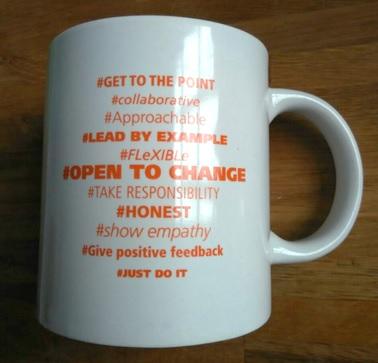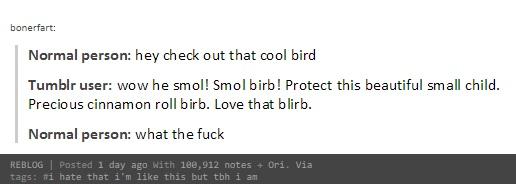
Aren’t you a bit too old for that?
A One Direction -fan, a former ING-intern and a Tumblr-user
Who are you? My answer to that question depends on who asks it, when and where. In this paper, I focus on three possible answers: A One Direction -fan, a former ING-intern and a Tumblr-user.
Looking at human life from an abstract point of view, one could say that it can be organized into structured mini-systems within which we situate our practices and behaviour. These mini-systems, or ‘micro-hegemonies’ as Jan Blommaert and Piia Varis (2011) call them, cover every aspect of our lifes and are subject to micro-hegemonic norms and standards. By following these micro-hegemonic standards, one will establish a ‘micro-selve’ which defines how others perceive, understand and evaluate us. Thus, micro-hegemonies eventually give shape to one’s identity. In this essay I will describe three micro-hegemonies in my own life. By doing this I aim to abbreviate on what a micro-hegemony entails and to explain related terminology like enoughness, recognisability, phatic communication, languaging, chronotopic identity and the importance of 'getting it right'.
When I reveal to people that I’m a ‘Directioner’ their reaction is almost always one of utter surprise. How often have I heard things like ‘aren’t you a bit too old for that?’ and ‘why One Direction?’
One Direction fandom – Recognisability and enoughness
One of the micro-hegemonies I would like to discuss here is the One Direction fandom. When I reveal to people that I’m a ‘Directioner’ (a fan of the popular British boy-band One Direction) their reaction is almost always one of utter surprise. How often have I heard things like, ‘aren’t you a bit too old for that?’ (I’m 24) and 'why One Direction?". The reason why people react this way is because I don’t meet their image of a ‘Directioner’; they don’t recognize me as an One Direction fan. When typing in the query ‘One Direction fans’ in Google Images almost every picture shows a hurdle of screaming teenage girls with self-made signs, wearing One Direction merchandise (figure 1).

Figure 1: One Direction fans
Yes, I listen to One Direction’s music and know all the band members by name. Yes, I have attended one of their concerts and yes, I even bought their fragrance ‘Between Us’ at Boots when I was in London this year. These are all practises that a true One Direction fan would perform, only they are ‘invisible’ practices. I would never wear One Direction merchandise, not at a concert and certainly not in everyday life. When attending a One Direction concert I would probably never make the effort to make a sign, take it to the venue and hold it up during the show, and I don’t talk to people about the band on a daily basis. The truth is, I do this on purpose. I know that if I would arrange features in such a way, they would enable others to identify me as an ‘authentic’ member of the One Direction fandom like the girls depicted in figure 1. People in my scholarly environment would very likely stop taking me seriously, and they would judge me on my appearance and my frantic fan behaviour. Such judgements are fundamentally rooted in recognisability: they recognize fan behaviour as being indexical of childishness and a certain naivety[1] (Blommaert & Varis 2012).
But when looking from within the fandom another issue occurs. If I would ask one of those girls in figure 1 if she thinks I am a true fan, what would she say? Her answer would probably be ‘no’. At best she would agree that I am a fan to the extend that I like listening to One Direction’s music and that I know a thing or two about the band[2], but would that be enough?
Being an authentic someone requires orientations towards certain resources that index a particular desired identity. The dose of those resources can be small, but the only thing that is required is that it is enough. At least enough to produce a recognisable identity as an authentic someone. Enoughness judgements determine the way in which one can rise from the ‘apprentice’ rank to higher, more authoritative ranks (Blommaert & Varis 2011). Thus, recognisability also has to do with degrees of doing. When doing too much or too little, one could be judged as a ‘wannabe’; someone who almost gets the micro-management right, but not quite so. This depends on the context of evaluation and the evaluator (Blommaert & Varis 2012). People from outside the fandom would not recognize me as being a One Direction fan, but after discovering that I am wearing the fragrance and how often I listen to their music they will most likely admit that I am a ‘Directioner’. True ‘Directioners’ however would probably agree on the fact that I am not being enough of a One Direction fan, because I am purposely hiding some indexical features of being a ‘Directioner’. Where does this leave me then?
After all I know that people might think of me as childish and immature when I would reveal to them that I’m a fan of this band, and therefore I am consciously not adopting enough of the indexical features and behaviours (f.e. buying merchandise, talking a lot about the band) that would make me recognizable as a fan. As a result, people indeed do not recognize me as such. Apparently I regard this micro-hegemony and it’s micro-hegemonic norms and values as a less important part of my identity, whereas people who choose to adopt all the indexical features think of ‘being part of the fandom’ as an essential part of their identity. If I would want to identify myself first and foremost as a One Direction fan, more than identifying myself as a college student for instance, I would have put more effort in getting those indexical details right. Furthermore, the girls in figure 1 obviously have adopted enough of the indexical features to make up for good examples of proud ‘Directioners’. However, looking at the crowd barriers and signs in this picture, they are clearly attending some kind of event: more specifically they are waiting for One Direction to perform at a venue in Australia. Chances are high that when they arrive at school the next day, a lot of the features that make them recognizable as being a One Direction fan are gone. They will change their 1D-garment for more casual clothing and of course they will not bring any of their signs to school. However, a hard core ‘Directioner’ would still have some One Direction stationary with them (Figure 2).

Figure 2: One Direction stationery set
In this sense, one could say that by 'degrees of doing' one can adjust their identity, increasing or decreasing the indexical features belonging to a specific micro-hegemony that determines recognisability. Here, being not a completely authentic fan, but a fan on an ‘apprentice’-level is enough for me.
ING – Chronotopic identity and 'doing it right'
A very different, but maybe one of the best examples of micro-hegemonies in practice, is the work floor of an professional enterprise. That is because in such an environment a lot of emphasis and pressure is placed on 'doing it right'. When not adopting enough indexical features of ‘business culture’ or ‘managerial style’ one can be judged as complete failures (e.g. as ‘trashy’ when trying to be ‘classy’) (Blommaert & Varis 2012). Instant recognisability as a business professional is inscribed in dress, make-up, mood and the orientation towards objects such as laptops and documents, but also in attitude towards the corporate identity of the company. A lot of large international companies these days maintain a ‘blueprint’ for the image that employees should carry out to the outside world.
When I was working as an intern at the headquarters of ING Group in Amsterdam, every employee, including the interns, had to align their actions and behaviour to the so-called ‘Orange Code’[3]. To promote the ‘Orange Code’ among employees, various activities were organized, posters were put up proclaiming the guidelines of the code and ‘Orange’ merchandise was handed out. Although my internship at ING is long over, I still own one of the mugs that was part of this orange-merchandise spree (figure 3). The mug once stood on a corner of my desk filled with pens and other stationary and acted as a daily reminder of the attitude we, as ING’ers, were supposed to hold up. Now, this mug has lost its function as encourager for the ‘Orange Code’. It sits in one of my kitchen cabinets and is merely a memento to my time as an ING intern.

Figure 3: ING mug
This sad mug story is an example of what Bathkin called a ‘chronotope’; the inseparability of time and space in human social action and the effects of this inseparability on social action. Chronotopes invoke orders of indexicality, valid in a specific timespace frame. Specific timespace configurations enable specific modes of behaviour as positive, desired or compulsory. This happens through the deployment of chronotopical relevant indexicals (in this case the mug and its ‘Orange Code’-message) (Blommaert 2015). The same goes for employees themselves when they leave the office. When I returned home after a long day of work at the ING office I would flop down on the couch and absolutely not be in the mood to be ‘#approachable’ and to ‘#just do it’, I would even wear a onesie and put my feet on the coffee table. In this sense, the actual practices performed in our identity often demand specific timespace conditions; a change in timespace arrangements triggers a complex and massive change in role, discourses and criteria for judgement of appropriate versus inappropriate behaviour (Blommaert 2015). So, recognisability is about getting all the details right. With assembling recognizable features one composes a jigsaw of indexicals that is in line with the normative expectations that generate recognisability in a specific time and place. This would be the same for the girls in figure 1. When the event ends, they will drop their signs, return home and get changed. After all, outside of One Direction events, carring those signs and wearing those shirts would not be appropriate.
Tumblr – Phatic communication and languaging
I would like to introduce the last micro-hegemony here, the micro-hegemony of Tumblr, with a post (figure 4) that was recently published by a user on the microblogging website[4] .

Figure 4: Tumblr post as found on shortintheworld.tumblr.com
I myself registered a Tumblr account about 8 years ago. Since then I have always been more or less active on that website and I keep a simple microblog that I frequently update. Each Tumblr post can be ‘liked’ and ‘reblogged’[5]. The amount of ‘likes’ and ‘reblogs’ are counted as notes under the post as shown in figure 4. In this case the post has 100,912 notes. Furthermore, there is a ‘via’-link that links to the page from which Tumblr user ‘shortintheworld’ reblogged this post. Besides this, there is a tag attached to the post, created by Tumblr user ‘shortintheworld’. It reads, “I hate that I’m like this but tbh I am”. Tags on Tumblr are used not only to categorize a post under a certain subject (this post could also have been tagged as ‘#bird’ for instance), but they are also used by Tumblr users to add short comments to the post they reblogged or wrote.
The message in this post seems ‘empty’ in the sense that no noticeably ‘relevant content’ is being communicated; such a message is typologically similar to the kind of ‘small talk’ which is identified as ‘phatic communication’. According to British-Polish anthropologist Bronislaw Malinowski (1884-1942), Phatic communication “serves to establish bonds of personal union between people brought together by the mere need of companionship and does not serve any purpose of communication ideas”. By liking and reblogging this post bloggers can show that they ‘identify’ themselves with the imaginary Tumblr user talking about the bird. The tag that is attached to this post makes this even more clear. Tumblr user ‘shortintheworld’ first reblogged the post and then added that ‘she hated she’s like this’.
Only someone who uses Tumblr frequently would know that expressions like ‘smol’, ‘birb’, ‘cinnamon roll’ and ‘precious child’ are common ways to attribute a certain cuteness to something.
Understanding this seemingly empty message, like understanding the One Direction sign in figure 1, is an essential micro-hegemonic norm. I, being someone who uses Tumblr frequently, know that expressions like ‘smol’, ‘birb’, ‘cinnamon roll’ and ‘precious child’ are common ways to attribute a certain cuteness to something on this website. This is something that a ‘normal person’, i.e. an outsider, would not immediately understand. A Tumblr user would also know that the abbreviation ‘tbh’ stand for ‘to be honest’, although this abbreviation also appears on online platforms other than Tumblr. This usage of text-specific features that are performed through fixed expressions and speech characteristics is called languaging.
Thus, what happens here is the emergence of ‘communion’ in the sense of Malinowski: identity statement expressing membership of some group. Such groups are not held together by high levels of awareness and knowledge of deeply shared values, like a religious community or a family for instance, but by loose bonds of shared forms of searchability and findability of “like”-minded people (Varis & Blommaert 2014). These kinds of groups are also known as ‘light communities’. On social media ‘light communities’ are communities where people gather and jointly act while focussing on lifestyle objects, meanings and practices.
In contrast to the previous example, a striking characteristic for these kinds of communities is that they involve no physical copresence, and are therefore not ‘chronotope’. Chronotopes involve specific forms of agency: specific patterns of social behaviour (indexicality) ‘belong’ to particular timespace configurations, like maintaining a professional attitude on the work floor of a specific company, in the ING, for example. However, communities on social media involve a copresence in a shared ‘virtual’ space of unknown scale-dimensions, an unknown number of participants of unknown identity, combined with a stretchable timeframe with an almost unlimited archive of online communicative material (Blommaert 2015). Hence, the joint focusing is in itself not trivial. The sharing of phatic communication with the right use of languaging translates a number of individuals into a focused collective here, in a superficial yet real way (Varis & Blommaert 2014). I feel like being part of a community because I can understand the ‘language’ of that community, however empty this language may seem on first sight.
Micro-hegemonies and my identity
I can conclude now that several microhegemonies provide an order composed of different niches of ordered behaviour and discourses, and the combination of such micro-hegemonized niches is what would make up someone’s identity; in this case my identity. The extent to which these niches take up their part in our identity is determined by different 'degrees of doing' and the level of recognisability. As we have seen in the first example, one can choose to purposely not adopt enough indexical features and maintain a lower rank of authenticity (‘apprentice’). Furthermore, we can arrange features in such a way that others identify us as ‘authentic’, demonstrating the revevant notion of enoughness. We can enter and leave these niches of our identity in rapid sequence, whether that is just by going from one place to another, or completely changing footing and style. Thus, we can steer our identities; they are as dynamic as we want them to be.
Endnotes
[1] Leaving aside the question if they are right to think so.
[2] For example: one of the signs in figure 1 reads “We got Nando’s 4 Niall”. To someone from outside the One Direction fandom this would not make much sense. They might not have a clue who Niall is or what Nando’s is (this restaurant chain is very popular in the United Kingdom), but among ‘Directioners’ it is well known that band member Niall is a Nando’s enthusiast and they are using this insiders-knowledge to get his attention.
[3] ING is a Dutch bank, they use orange as their branding colour.
[4] A microblogging website is a website which enables its users to create a blog and publish small text and multimedia posts on it. These posts usually consist of just one single picture or a few lines of text.
[5] When a post is reblogged by a Tumblr user, the post will be placed on the blog of that Tumblr user. This feature is similar to ‘sharing’ posts on Facebook.
Literature
Blommaert, J. & P. Varis (2015) Enoughness, accent and light communities: Essays on contemporary identities. Tilburg Papers in Culture Studies paper 139.
Blommaert, J. (2015) Chronotopic identities. Tilburg Papers in Culture Studies paper 144.
Varis P. & J. Blommaert (2014) Conviviality and collectives on social media: Virality, memes and new social structures. Tilburg Papers in Culture Studies paper 108.
Blommaert J. & P. Varis (2012) Culture as accent. Working papers in Urban Language & Literacies paper 86.
Blommaert J. & P. Varis (2011) Enough is enough: The heuristics of authenticity in superdiversity. Tilburg Papers in Culture Studies paper 2.